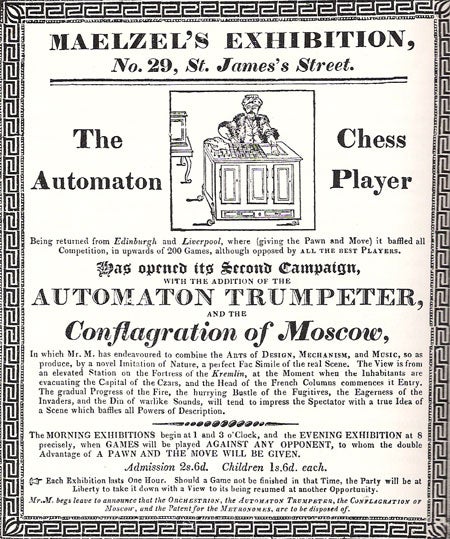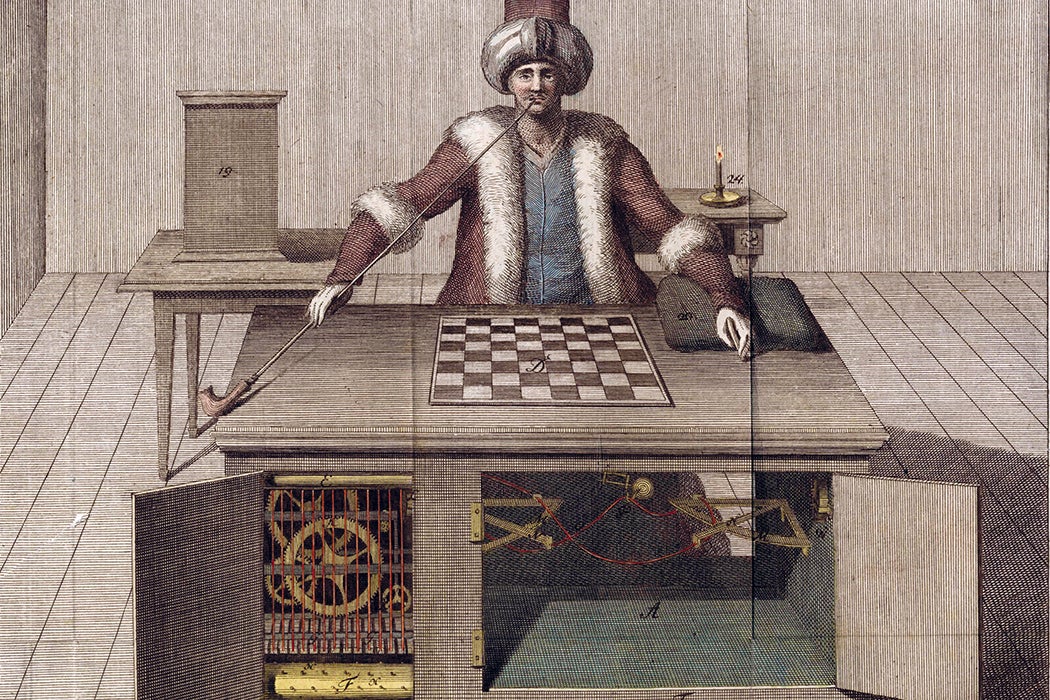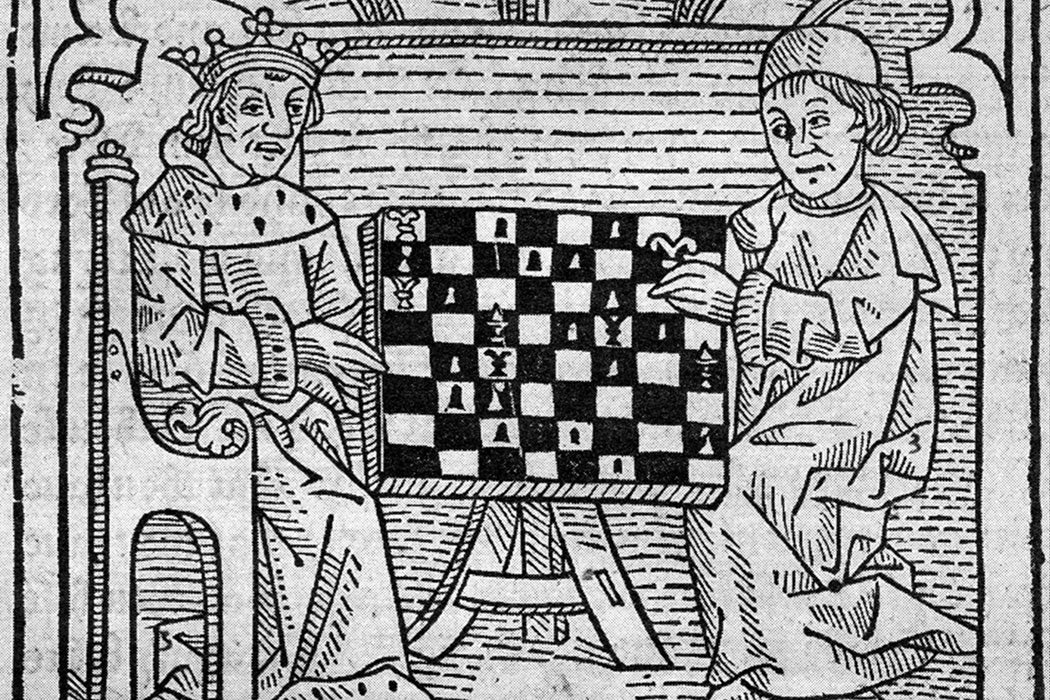You might be surprised to learn that a Hungarian engineer named Johann Nepomuk Maelzel was the entertainment sensation of the 1820s and ’30s in America, but stranger things have happened. On tour with an automaton chess player known colloquially as “the Turk,” Maelzel captivated audiences wherever he went; no less than P. T. Barnum considered Maelzel “the great father of caterers for public amusement.” Edgar Allan Poe would memorialize Maelzel’s chess player in an essay purporting to debunk the entertainment, a work many fans consider an early effort to develop his skills at detective writing.
The origins of the chess player stretched back well before the time of Barnum and Poe. Consensus holds that when a French inventor provided a magnetic demonstration before the eighteenth-century court of Empress Maria Theresa of Austria, an engineer named Farkas de Kempelen decided he would compete for the Empress’s amusement. He promised he would return with “a piece of mechanism, which should produce effects far more surprising and unaccountable than those which she then witnessed,” writes Mark Sussman, quoting an 1819 pamphlet written about the automaton chess player then on exhibit in London. Six months after his assertion, de Kempelen returned with a player “costumed as a Turkish sorcerer seated at a chess board.”
The life-sized automaton was positioned before a wooden cabinet about a meter in width. Dressed in a turban and exotic cloak, the “Turk” rested one arm on a cushion and held a long pipe in the other. The operator began each performance by swinging open doors on the front of the cabinet to show that there was no trickery involved before inviting volunteers to play a game of chess with the machine. The Turk typically won.
“With its downcast eyes and mustache,” writes Sussman, “the figure suggested the Orientalist fantasy of a sorcerer or fortune-teller.” Or, if you’re a fan of the movie Big, it wasn’t unlike an early, chess-playing Zoltar, with all of the associated suggestions of mystery and exoticism.
The empress, and later crowds, were delighted. After de Kempelen’s death, Maelzel acquired the machine; he brought it to the United States in 1826 and performed demonstrations until his own passing in 1838. (After Maelzel’s death, the Turk made its way to the Chinese Museum in Philadelphia, where it was lost to fire in 1854.)
Crowds came to see the automaton chess player for reasons ranging from the simple desire for entertainment to a more complex engagement with early nineteenth-century ideas of individualism and agency. Automata were emblematic of shifting boundaries between technology and magic, and easily played into the individualism of the era of Jacksonian democracy. And no sooner did people go to see the automaton than they started to talk about how it did (or didn’t) work. In 1821, when the machine was still in Europe, an analysis of its mechanics and chess moves was published as the pamphlet An Attempt to Analyse the Automaton Chess Player of Mr. De Kempelen. Letters on Natural Magic, an 1832 correspondence series between Sirs David Brewster (inventor of the kaleidoscope in the early 1800s) and Walter Scott, includes the Turk in its examination of entertainments that blended science and magic.

And in 1836, Edgar Allan Poe took to the pages of the Southern Literary Messenger with his take on what was really going on with the chess-playing contraption. In his mid-twenties and still struggling to get a career off the ground, Poe was arguably seeking a byline as much as anything and looking to both train and prove his abilities in what he would later term “ratiocination.” LeRoy L. Panek, a scholar of detective fiction, explains that “Poe’s detective stories were preceded by a number of essays in which the author exercised his own abilities as a detective on various material problems like hand writing and cryptography.” The chess automaton would have been readily known to readers and steeped in sufficient “how’d he do it?” speculation to make such an essay appealing.
Poe set up his inquiry, musing that
[t]he interior of the figure, as seen through these apertures, appears to be crowded with machinery. In general, every spectator is now thoroughly satisfied of having beheld and completely scrutinized, at one and the same time, every individual portion of the Automaton, and the idea of any person being concealed in the interior, during so complete an exhibition of that interior, if ever entertained, is immediately dismissed as preposterous in the extreme.
He concluded that human agency must be involved—after all, a pure machine would always win and sometimes the automaton lost to its challenger—and that the size, shape, and operation of the cabinet suggested that it concealed a person.
More to Explore
Knights and Kings: Medieval Chess as Male Bonding
Poe wasn’t treading new ground, to be sure; scholars have suggested that he leaned heavily on Brewster’s work or that he gleaned source material from the Baltimore newspapers, one of which quoted a claim by teenagers that they saw a man emerge from the cabinet. Regardless of his context and sourcing (and the fact that he was close but not 100 percent correct on the actual mechanics), Poe’s essay is a fascinating example of the pipeline that in the 1800s brought science from an elite academic practice to an increasingly publicly arbitrated discipline. His solution is imperfect, but it’s well remembered because of his enduring reputation, his ability to write clearly and with charm, and his development of a popularly understandable sense of ratiocination and puzzle-box appeal. No surprise that Sir Arthur Conan Doyle would look to Poe and his detective C. Auguste Dupin when creating the equally deductive Holmes.
Weekly Newsletter
The automaton was popular (and worrying) to nineteenth-century crowds for reasons that seem resonant again today in light of machine learning and AI. This wasn’t a trick machine that could simply dance or move a ball: it appeared to think and move, to be able to control circumstance and interact with humans, perhaps even with superiority. As Stephen P. Rice explains,
Even if people didn’t believe the automaton could think independently, new and sophisticated industrial machinery could certainly do tasks well enough to make people worry that it could usurp a job, dehumanize a human operator, or, over time, develop into a thinking machine. In 1848 Scientific American proclaimed that automata for entertainment were merely steps towards a weightier social and capitalist purpose, proposing that
Machinery is no longer meant to amuse, but to “benefit man and increase the product of the earth.” The editors of Scientific American (subtitle: The Advocate of Industry, and Journal, of Scientific, Mechanical and Other Improvements) had a vested interest in promoting the benefits of industrialization, of course, but this explicit belief in the beneficial nature of machines does make one wonder what they would think about how “mechanical powers” are wielded around the globe, a century and three-quarters on.








